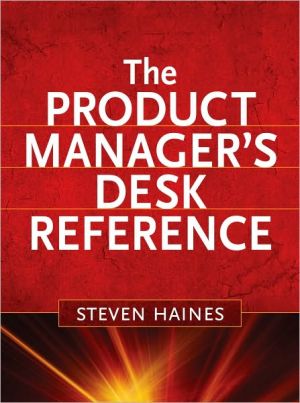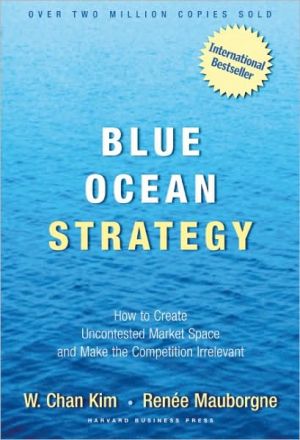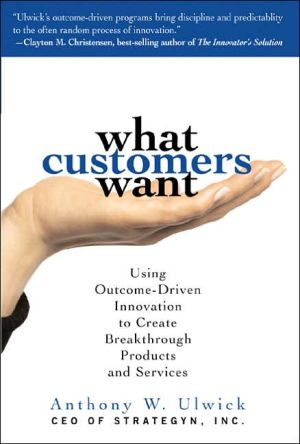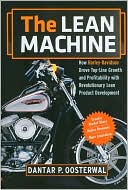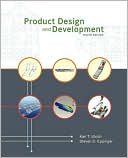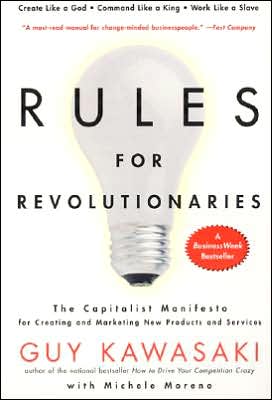The Product Manager's Desk Reference
"The Product Manager’s Desk Reference is outstanding\ in covering the breadth of the tasks and thought\ processes involved in product and innovation management."\ -George Castellion, SSC Associates\ “Every product manager will greatly benefit from having this reference manual in their office as they live through the exciting twists and turns of product management.”\ -David Anderson, Managing Director, B2B Channels, United Airlines\ “An excellent tool for beginners and experts alike. Steven...
Search in google:
"The Product Manager’s Desk Reference is outstandingin covering the breadth of the tasks and thoughtprocesses involved in product and innovation management."-George Castellion, SSC Associates“Every product manager will greatly benefit from having this reference manual in their office as they live through the exciting twists and turns of product management.”-David Anderson, Managing Director, B2B Channels, United Airlines“An excellent tool for beginners and experts alike. Steven Haines's practical experience and knowledge shine through at every step.”-David Rosshirt, Director of Product Management, First Data International“From now on, this book will stand as an important reference point for all product management teams.”-Mark Elliott, Vice President Product Management, Smiths Detection“The Product Manager's Desk Reference is the book all product managers have been waiting for. It is concise, to the point, and comprehensive.”-Carol-Ann Matignon-Berlioz, Vice President Product Management, Fair Isaac“A must-have for every product manager, this book contains a wealth of information, advice and practical tools that will lead to success for both the Product Manager and the organizations they serve.”-Jeff Anderson, Senior Vice President Product Management, Franklin Covey“Steven Haines covers this multifaceted topic in a systemic manner that makes the book easy to navigate. His groundbreaking proposal that Product Management become a formal disciple is an accurate reflection of the acute need for these skills in the business community.”-Dan O'Day, Senior Director Product Management, Thomson ReutersAbout the BookWhether a business sells tangible goods or services, product management holds a critical position in the organization's pursuit of profits. Because traditional departmental roles continually evolve, and because the business climate is so competitive, the job of product manager has become exceedingly critical—yet it remainsvery complex. The Product Manager's Desk Reference is the first book to lay down a comprehensive body of knowledge for thiscritical function, and it is the only book that can effectively guide product managers so that they can establish and build a successfulcareer in product management.Here, product management expert and practitioner Steven Haines clearly illustrates the entire product life cycle, from beginning to end. This outstanding work is packed with an array of best practices and helpful hints which are critical to the efficient management of products.The Product Manager's Desk Reference is punctuated with useful diagrams, tables,and templates and will help you: Create a master plan of record for your product Formulate actionable strategies Incorporate market data into important decisions Set the stage for creating innovative products Optimize existing products and product portfolios Apply financial techniques to manage product profitabilityThe Product Manager's Desk Reference embodieseverything “Product Management.” It is a comprehensive, versatile, must-have resource for anyone who works in any company, in any industry, who seeks to successfully and profitably market and manage products and services.Steven Haines is the founder and presidentof Sequent Learning Networks, a trainingand advisory services firm with an internationalclientele, based in New York City. Hehas over twenty-five years of corporate experiencein finance, marketing, and productmanagement. Haines honed his craft inindustries as diverse as wholesale industrialproducts, intimate apparel, medical products,communications, and software & technology,holding leadership roles at AT&T andOracle. Further, he spent twelve years as anadjunct professor at Rutgers University’sbusiness school. He holds an undergraduatedegree in Management Science with aminor in Organizational Behavior fromBinghamton University and an MBA inCorporate Financial Management from theLubin School of Business at Pace University.
THE PRODUCT MANAGER'S DESK REFERENCE\ \ By STEVEN HAINES \ McGraw-Hill\ Copyright © 2009 Steven Haines\ All right reserved.\ ISBN: 978-0-07-159135-5 \ \ \ Chapter One\ WHAT IS PRODUCT MANAGEMENT?\ Executive Summary\ * Product Management is the "holistic business management of the product" from the time it is conceived as an idea to the time it is discontinued and withdrawn from the market.\ * The product manager plays a central role in Product Management. As the "mini- CEO" for the product, he or she leads a cross-functional team to achieve the product's strategic intent.\ * Organizations can achieve greater levels of efficiency if everyone uses a common vocabulary when referring to practices, processes, and documents.\ The Introduction states that Product Management is the pivot point of successful business. However, the job and its associated responsibilities are poorly understood and inconsistently applied. Before offering a remedy for this situation, it's appropriate to explain precisely what I mean by "Product Management." I'll do this by breaking down the two words, Product and Management, analyzing the pieces, and putting the terms back together. You will master the "how" much more quickly when you comprehend the overall context for the discipline of Product Management. Just like the assembly-disassembly demonstrations that apprentice mechanics are shown before learning to repair an engine, this chapter offers a rapid, break-down-and-reassemble orientation to Product Management. If you're using this book for sequential study, it also improves your grasp of the material if you understand the overall concepts covered in the book.\ Four questions must be answered to completely define Product Management:\ 1. What is a product?\ 2. What is management?\ 3. What is Product Management?\ 4. How does Product Management transform a product?\ In this chapter, each of these questions will be explored in turn.\ QUESTION 1: WHAT IS A PRODUCT?\ In the PDMA Handbook of New Product Development (2nd ed., Wiley), the glossary contains the following definition for Product: "A term used to describe all goods, services, and knowledge sold. Products are bundles of attributes (features, functions, benefits, and uses) and can either be tangible, as in the case of physical goods; intangible as in the case of those associated with service benefits; or can be a combination of the two." Webster's online dictionary indicates, "A product is something that is produced."\ These definitions don't lend themselves well to this discussion. A product is not always just a single product; there is usually a hierarchy of products and services within a firm. A product may be part of other products or product lines, packaged with a group of products, or included in a product portfolio. Alternatively, products can be broken down into product elements, modules, or terms (as in a credit card). Products may be built upon product platforms or product architectures. In order to visualize this hierarchy, consider the model shown in Figure 1.1.\ The first order of business, then, is a workable definition of a product. A product is anything that is sold, tangible or intangible. Products are created by businesses to sell to other businesses (business-to-business, or B2B) or to consumers (business-to-consumer, or B2C). They can even be created by businesses that sell to other businesses, which ultimately sell to consumers (business-to-business-to-consumer, or B2B2C). Some products are merely resold to end customers, and some are sold as parts of other products.\ Think of how an automobile parts manufacturer sells parts to an automobile company. The auto company is actually an assembly business—in most cases, they don't even manufacture any of the parts. Auto companies sell to dealers (other businesses) who ultimately sell to consumers or other businesses.\ Product Lines\ Frequently, companies collect a number of related products into product lines. Very few companies carry isolated, one-off products. A product line, depicted in Figure 1.2, is a grouping of products focused on similar markets, or on solving a particular type of problem. Typically, products within a line serve similar markets or can be produced via similar methods. A product line, in effect, is a small product portfolio. For example, BMW Group has several different automobile product lines: The Mini brand, the Rolls-Royce brand, and the BMW automobile brand. The BMW Automobile Division has several cars in its product line. These product lines are depicted in Figure 1.3.\ Product Portfolios\ In some companies, especially larger organizations, several product lines may be grouped into a related collection called a product portfolio. The common attribute of a given portfolio might be the markets on which the products focus, the type of product, or even the specific source or manufacturing method used. A market example might be a medical device company that groups three product lines—hearing aids, reading glasses, and motorized wheelchairs—into a "seniors" portfolio. An example by type of product would be a toy manufacturer with a cycle portfolio, consisting of three product lines: tricycles, mountain bikes, and BMX bikes. Similarly, a cookware company might divide its portfolios by type of metal, having a cast-iron product portfolio, an aluminum portfolio, and so forth.\ The choice of organizing principle for a product portfolio will vary widely from company to company. In rare instances, one product line may be assigned to two different portfolios at the same time. For example, a major computer equipment vendor has a secure server product that sits both in the security portfolio and the multiprocessing computing portfolio. Ideally, this would not be the case, but in some instances, this kind of dual assignment might make sense.\ A product portfolio, then, is the set of all products or product lines, or other groupings (within a business unit or business division). Portfolios can be mixtures of existing products, which may be at various phases of their own life cycles, as well as incoming products (those anticipated, actually in development, or in the launch phases). In smaller organizations, your product or product line may in fact represent the entire portfolio. A visual example of this type of product portfolio is shown in Figure 1.4.\ Much of what I say about Product Management can be applied directly to portfolios as well. Product portfolio management and related activities of portfolio optimization and balance are an important part of the strategic planning and strategic management of the organization, whether that organization is a company, business unit, division, or product line.\ Extending the previous example for BMW Group, the portfolio of automobile lines is shown in Figure 1.5. BMW Group also has a financial services division, a motorcycle division, and a retail division. All of those divisions comprise the entire BMW Group portfolio.\ Solutions and Bundles\ Related products and services will sometimes be grouped into solutions or bundles. The word solution seems to be used more frequently in the BtoB arena. Solutions are usually highly complex because they solve complex problems, have a high degree of integration across disparate elements, and usually require customization for a specific customer type or industry. An organization that focuses on solutions should be structured to support solutions-based marketing and selling. A good structure is a solutions marketing group, whose role is to size up business and market opportunities and then to bring together the needed elements, products, and services, sourced internally or externally. Typically there's a large consultative aspect of every solution sale.\ Solution is sometimes used inappropriately. Every product should be a solution to some problem. If you assume that every product is really a benefit-filled solution, then every company is really in the solutions business. The reality is, however, that grouping products together when they don't solve a customer's problem from start to finish is merely the act of bundling. There is an easy, quick way to determine whether a given solution is actually a bundle. In a B2B setting, if purchasing agents can pick the offer apart to shop the piece parts, it is a bundle.\ Bundling can be an appropriate strategy, but bundles held out to be complete, seamless solutions might create excess overhead for the organization. Companies should avoid adding overhead to the business if it doesn't increase profit or add value for the customer. Bundles do not generally contribute much to product profitability, so they may be more trouble than they're worth.\ Figure 1.6 provides a conceptual snapshot of a solution in a B2B environment. In this case, several internal product lines and a product from an external company are assembled, to which value-added programs are supplied, such as consulting and operational support. The package adds value for customers because it offers the full range of problem resolution, including diagnosis, solution recommendations, implementation, and integration. The components of this solution cannot be shopped separately, so it is a genuine solution.\ Here's an example of how a real solution might come about. IBM sells solutions. It brings products and services together, both from its own divisions and other partners. IBM and its partners believe that there is tremendous added value to customers if they are the single face to the customer, offering both diagnostics and problem solving.\ Now, suppose a company makes medical devices and your customers are complaining of delayed shipments, damaged goods, and incorrectly labeled parts. This is costing time, money, and reputation. IBM has a consultative session with the stakeholders and executes a process discovery, whereupon they realize that the company has a supply chain problem. It can be addressed with some physical products (from Cisco®), some software (from Oracle®), and some services from IBM consulting. IBM offers to be the single point of contact for complete business analysis, customization, implementation, testing, turn-up, and postsales support. Since the medical device company doesn't have the people resources to analyze and fix complex problems like this, and they can't easily purchase this combination of products and expertise as separate line items, they purchase the solution.\ Product Elements and Modules\ Another key distinction in the definition of products is the idea of product elements or modules. For tangible products, these are product components that may be treated as "black boxes" inside the product. For example, if an appliance company buys electric motors from another firm in order to manufacture appliances, then the motor is a product element. If the motor is mounted in a larger housing with a wiring harness, then that could be called a "power module" or some equivalent expression indicating that it is a subassembly as a part of the product.\ If another division supplies a product with a complex part at a suitable price, it may not be valuable to break down the part into individual components. For example, when developing software, modules of the code could be sourced elsewhere and then linked together later. There are also intangible modules, which might include features or terms. A bank's credit card line, for instance, may treat features, terms, or conditions as product elements. Whatever these modules, elements, or sub-assemblies are, they are building blocks of a product that may require individual Product Management oversight in their definition, design, and integration with a larger product or solution.\ Platforms\ The last piece of the product puzzle to be defined is the product platform. The platform represents the underlying foundations, technology frameworks, base architectures, and interfaces upon which products are built. The platform provides commonality so that a higher degree of standardization can be achieved across a portfolio. This standardization contributes to higher economies of scale and greater flexibility in designing and styling products, so that the company can meet the needs of different market segments or customers. For example, the automobile industry effectively uses platforms for their cars. Honda has several product platforms. One of those is called the CD platform, on which it builds its Accord model for Asia and North America, the Odyssey Minivan, and the Acura TL (in the United States). Another is the C platform, used as a basis for the Civic, Acura RSX, CR-V, and Element (U.S.) models. As well, many companies actually share parts and other product elements or modules across their platforms, some of which might include motors for electric windows, speedometers, and other components. Figure 1.7 helps visualize this concept.\ In The Power of Product Platforms, Marc Meyer and Alvin Lehnerd state: "Product platforms must be managed. If a platform is not rejuvenated, its derivative products will become dated and will fail customers in terms of function and value. If a company's platforms are renewed periodically ... redesigned to incorporate new functions, components, and materials, the product family will remain robust through successive generations." They go on to say "Robust product platforms do not happen by accident. They are the result of a unique methodology and of strategies for designing, developing, and revitalizing them over time."\ Platform usage can be problematic for some large companies that have grown through mergers and acquisitions. Issues arise because platforms are so complex (and old) that they are sometimes difficult to merge into a unified platform. Large banks for example, may have many different platforms for processing credit card transactions or for managing deposits. If you contact a large banking company's call center, you may be asked about the state or region in which you live, so they know which system to access. In one of my corporate jobs, we visited a wireless phone company that had gone through many mergers. They were distraught because they had five different billing systems, and the bill- consolidating mechanism was "dropping" about 30 percent of the billing records, causing the company to lose millions of dollars in revenue.\ QUESTION 2: WHAT IS MANAGEMENT?\ Thus far, I've focused on products: I defined the different kinds of products and product offshoots, whether they are product lines, product elements and modules, platforms, solutions, or the product portfolio. The second major part of this discourse on Product Management focuses on the art of management itself. Management is the second word in the phrase "Product Management," with its roots in Latin: manu agere, or "to lead by the hand." In most books about management, definitions generally include the usual cycle of business elements:\ * Setting goals\ * Directing human and financial resources\ * Assessing outcomes\ * Reassessing/resetting goals\ I recall a professor from college saying "managing means getting things done ... period." They're all generally saying the right things.\ In Product Management, the person in charge is the product manager. Based on the definition of product given earlier, it is not correct to assume a one-to-one relationship of product to product manager, though that may be the case in some organizations. A product manager can be partly or wholly responsible for all or part of a product platform or architecture, a module or series of modules, a single product, a product line (a small product portfolio), or several product lines (a larger portfolio).\ What is a Product Manager?\ * The product manager is a person appointed to be a proactive product or product line "mini-CEO" or general manager.\ * The product manager leads a cross-functional product team.\ * The product team's responsibility is to optimize the product's market position and financial returns, consistent with corporate, business unit, or division strategies.\ What Does a Product Manager Really Do?\ As a general rule, it would be very easy to say that the product manager is responsible for making sure that everything gets done. This level of responsibility assumes the product manager has a number of distinct competencies. These competencies cannot be perfectly honed down to a finite number of actions, but there are some specific practices ("things you do") that are more successful in the long run. These practices include:\ * Leading and influencing. There is a distinct difference between managing and leading. Managing implies explicit authority over individuals. Leadership, on the other hand, means you must convince those individuals to follow your vision.\ (Continues...)\ \ \ \ \ Excerpted from THE PRODUCT MANAGER'S DESK REFERENCE by STEVEN HAINES Copyright © 2009 by Steven Haines. Excerpted by permission of McGraw-Hill. All rights reserved. No part of this excerpt may be reproduced or reprinted without permission in writing from the publisher.\ Excerpts are provided by Dial-A-Book Inc. solely for the personal use of visitors to this web site. \ \
Introduction The Accidental ProfessionModule 1 Foundational Elements for Product ManagementCh. 1 What Is Product Management? 5Ch. 2 The Product Master Plan 29Ch. 3 Leadership: Creating Influence 45Ch. 4 Cross-Functional Product Teams: Getting Things Done 61Ch. 5 Decision Making: What's Next? 85Ch. 6 Finance for the Product Manager: Keeping Score 105Module 2 Making the Market Your Primary FocusCh. 7 The Playing Field and the Players: Analyzing the Industry and Competition 135Ch. 8 Finding Markets to Conquer by Understanding Customer Needs and Market Segments 167Ch. 9 Preparing to Set Your Mileposts: Forecasting for the Product Manager 191Ch. 10 Strategic Product Planning: The Inflection Point 215Module 3 The Start of the Product's Journey and the New Product Development ProcessCh. 11 Making a Molehill out of a Mountain: The Concept Phase 265Ch. 12 Is There Really a Business Here? Assessing Feasibility 289Ch. 13 Appearances Are Everything: Defining the Product 319Ch. 14 Justifying Product Investments: The Business Case 353Ch. 15 Synchronizing the Gears: The Marketing Plan for the Product 385Ch. 16 Execution and Oversight during Product Development 413Ch. 17 Introducing the Product and Orchestrating the Launch 445Module 4 Continuing the Journey: Post-Launch Product ManagementCh. 18 Auditing Results after the Launch 471Ch. 19 Post-Launch Product Management: Running the Business 485Ch. 20 Life Cycle Product Portfolio Management 521Ch. 21 Enough's Enough! Discontinuing the Product 543Module 5 Professionalizing Product ManagementCh. 22 Charting Your Career559Ch. 23 Organizing for Product Management 569Module 6 The Product Manager's Tool Box 591Glossary 643Resources and References 677Bibliography 685Index 689
